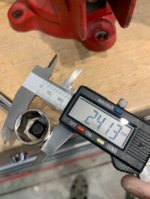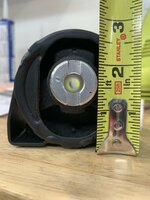Hi gang,
One drawback to eliminating primary order vibration is that it makes you (me) so sensitive to vibrations that you (me) notice secondary and tertiary order vibrations.
As a recap, I recently replaced my tires which were slightly flat spotted, which were causing primary order vibrations at speed.
Replacing and road force balancing the tires exposed secondary micro-vibrations that were felt through the steering wheel at 65mph+. These micro-vibrations could be seen with the eye as the steering wheel would micro-vibrate.
Re-roadforce balancing the fronts wheels (0.25 oz difference on 2nd balance) and adjusting the front alignment (toe, especially RF toe was way off at 0.50* toe in) eliminated those secondary micro-vibes and the steering wheel is now smooth.
Solving this matter, however, has now exposed tertiary order nano-vibrations which can be felt through the floorboards, and most discernible at 68mph. Lower speeds don’t manifest these tertiary vibes unless *perhaps* when the car is under load (steep uphill).
I am going to re-roadforce balance the rear wheels but I suspect maybe the issue is not wheels, but is related to aging (but not totally deflated or completely worn) motor/trans mounts.
The car is already smoother than a vast majority of the 30 year old w124s but I am in search of the ne plus ultra of smoothness.
The two driveshaft flex discs and center support bearing were replaced in 2017, 9000 miles ago. However, my records show that a previous owner replaced the motor mounts 12 years ago and 20K miles ago.
My question is - how likely is it that the TIME (12 years) has contributed to some deterioration of the motor mounts?
As well, anyone have any thoughts on “while you are in there” type activities to conduct during motor/trans mount replacement?
Thanks
One drawback to eliminating primary order vibration is that it makes you (me) so sensitive to vibrations that you (me) notice secondary and tertiary order vibrations.
As a recap, I recently replaced my tires which were slightly flat spotted, which were causing primary order vibrations at speed.
Replacing and road force balancing the tires exposed secondary micro-vibrations that were felt through the steering wheel at 65mph+. These micro-vibrations could be seen with the eye as the steering wheel would micro-vibrate.
Re-roadforce balancing the fronts wheels (0.25 oz difference on 2nd balance) and adjusting the front alignment (toe, especially RF toe was way off at 0.50* toe in) eliminated those secondary micro-vibes and the steering wheel is now smooth.
Solving this matter, however, has now exposed tertiary order nano-vibrations which can be felt through the floorboards, and most discernible at 68mph. Lower speeds don’t manifest these tertiary vibes unless *perhaps* when the car is under load (steep uphill).
I am going to re-roadforce balance the rear wheels but I suspect maybe the issue is not wheels, but is related to aging (but not totally deflated or completely worn) motor/trans mounts.
The car is already smoother than a vast majority of the 30 year old w124s but I am in search of the ne plus ultra of smoothness.
The two driveshaft flex discs and center support bearing were replaced in 2017, 9000 miles ago. However, my records show that a previous owner replaced the motor mounts 12 years ago and 20K miles ago.
My question is - how likely is it that the TIME (12 years) has contributed to some deterioration of the motor mounts?
As well, anyone have any thoughts on “while you are in there” type activities to conduct during motor/trans mount replacement?
Thanks
Last edited:













